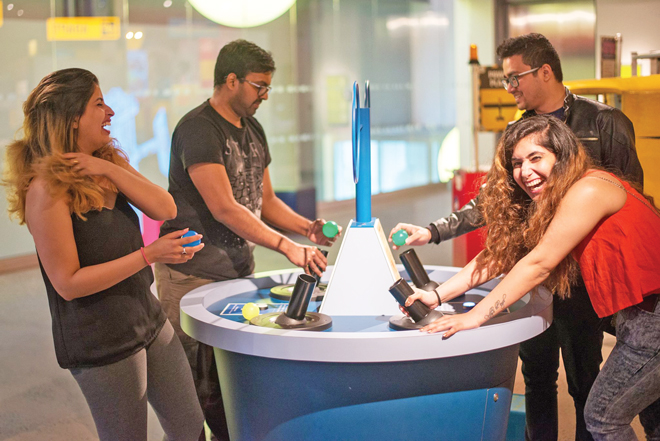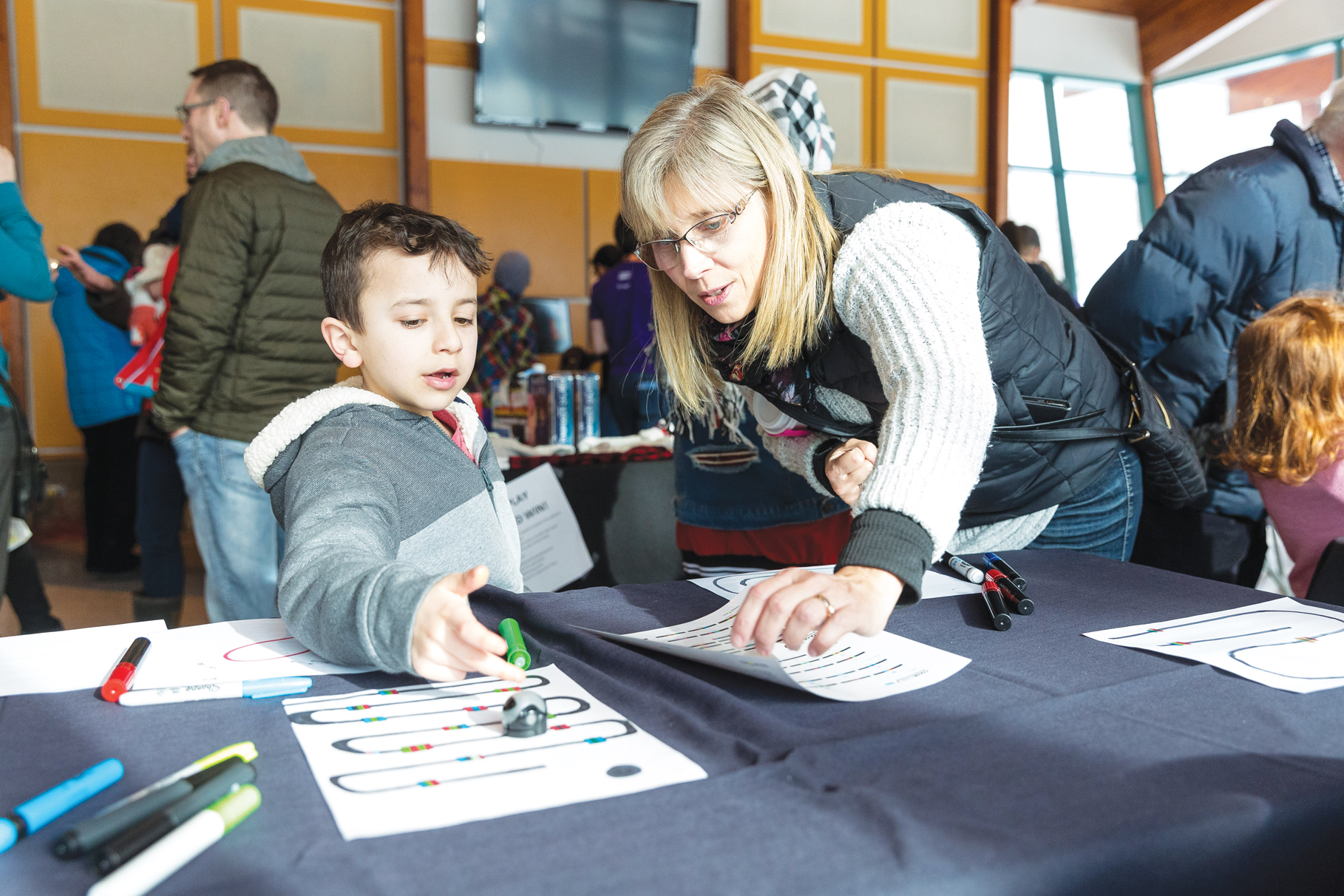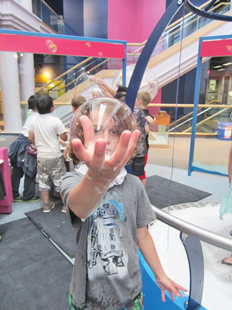A group of students experimenting. Science World. Photo — Taehoon Kim
Widening our scope for the 21st century
Tracy Calogheros
We all work in an incredible industry; exploring and educating on art, history, culture, language, science (yes science, because Canada’s science culture runs deep), in a progressive country that seeks to embrace a triple bottom line: individual well-being, environmental sustainability and economic health. I have always played in an interdisciplinary institution at The Exploration Place, but it has been my stint as Board Chair for the Canadian Association of Science Centres which has really drawn into focus for me just how lucky we are to have a museum industry like the one here in Canada; trusted, inclusive and ever-evolving.
People enjoying an outing at Discovery Centre. Photo — Mark Santos
Our museums hold our collective memory and serve as inspirations to our leaders of tomorrow; after all, to learn from our mistakes we must remember them. Interestingly a similar adage but future-focused, has guided much of the development of Canada’s Science Centres over the last 50 years. That idea is that no kid wakes up at eighteen and decides that they want to be an engineer or an astronaut unless they have engaged with those sciences at an early age. For Canada to continue to be a world leader in science, research, and innovation, we need to have young people who can think critically and creatively; pursuing careers in STEAM (Science, Technology, Engineering, Arts and Math). The experiential style of learning marked by the opening of the Ontario Science Centre (OSC) in 1969 has become the gold standard for public engagement and early educational investment in STEAM pursuits with results that are visible around the world.
The national survey done by OSC a few years ago names science centres as one of Canadians’ most trusted sources of information; more so even than universities and scientists. That level of public trust is hard earned and has proven to be essential throughout the pandemic as all of us sought to find answers for questions on epidemiology, viral spread, and possible eradication. Our Centres were amongst the first to shut down nation-wide and to pivot to an online method of delivery; an example that led the way for other organizations, outside the museum industry, to follow suit. Canada has, by comparison, been very successful at engaging the general public in the necessary measures to protect us all; largely because the level of scientific literacy is quite high in the population. With over 10 million visits a year to Canada’s science centres it is not unreasonable to draw a line between our national investment in those centres and our citizens’ ability to grasp and respond to the guidance offered by our top medical professionals.
Community participants learning coding through Ozobots at the Tech Up Community Showcase at The Exploration Place in Prince George. Photo — The Exploration Place
Canada loves its scientists; we produce many who have not just advanced their practice but who serve as inspiration to the next generations. Famous Canadian astronaut, Commander Hadfield regularly cites his childhood visits to the OSC as the spark that moved him to pursue his work in outer space; Governor General Julie Payette was the first Canadian to visit the International Space Station and work there, later becoming the CEO of the Montreal Science Centre before her prestigious government role. The connection between our scientists and science centres is a two-way street, with those who have been inspired to advance Canadian science returning to their science centres to in turn, inspire the innovators of tomorrow.
Young participant at a Saskatchewan Science Centre Summer Day Camp. Photo — Saskatchewan Science Centre
The challenge for our industry as we move through this pandemic, is to learn from our successes and mistakes, and apply that learning to the other collective challenges we are facing; reconciliation with Canada’s First Peoples, climate change, systemic racism and those yet unforeseen, like future pandemics. We have the talent and the tools in our museums, galleries, science centres, zoos, aquariums and botanical gardens. We have relationships with virtually all Canadians through our centres and Canadians have told us that they trust us. We have a responsibility to engage with these threats to our survival in depth, and at all levels, in order to help Canadians successfully face this uncertain future with confidence and facts.
Canada has always defined its museums broadly, encouraging cross-pollination between different organizations and partners in industry, education, policy and communication; therein lies the secret ingredient of our success. By refusing to allow the politicization of science, by respecting the role of culture, by informing innovation with historic experience, Canada’s Museum Industry has successfully navigated the first two decades of this new century to the benefit of all Canadians; so where do we go from here?
Science demonstration at Discovery Centre. Photo — Mark Santos
Our world is becoming ever more connected, the coronavirus is taking advantage of that to our detriment. We have the opportunity to combine that global interconnectivity and the trust we enjoy from our public, with our stated desire for increasing cross-pollination between areas of practice to find unique and effective solutions to the existential threats we are collectively staring down in this century. There are lessons in our history, inspiration in our arts and our museums are the public forums to explore both. As we envision what our response will be to public engagement in a post-covid world, it is imperative that we embrace this role as a safe place for difficult discussions. We must bring people together, virtually and in person, in ways that are physically safe and emotionally supportive while not avoiding the tough conversations we need to have. We need to help Canadians to navigate and dial back the rhetoric and “tribalism” that is on full display across the media and world-wide political leadership, encouraging them instead, to set aside differences in the name of the collective good. To be able to credibly offer that leadership means that we need to face that same challenge within our industry and between our differing practices.
The Canadian Museums Association (CMA) is a long-standing leader that has successfully embedded the value of our organizations in Canadian culture and government policy, yet even it has not always been open to differing ideas and approaches within the industry itself. Today the CMA is working to evolve, to include our wide-ranging facilities in their advocacy, their strategic planning, and their celebrations. I, for one, am excited about the role we all have to play in the decades to come. We are truly lucky to live where do and to work for organizations that are inextricably intertwined with our global future. There have been scary times before for humanity; you have only to look to our archives to see that with time, compassion, and data, this too shall pass. Canada’s museums (using the broad and inclusive definition of that term) have an exciting opportunity to rethink their role(s) in that future and take a leadership position as Canadians turn their attention to those other key challenges we are working on together. M
Tracy Calogheros is the President of the Canadian Association of Science Centres and the CEO of The Exploration Place Museum + Science Centre in Prince George, BC.




